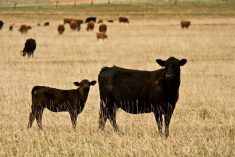Compared to last week, western Canadian yearling markets were down $4-$6 while calf prices dropped $5 to as much as much as $10 in some cases.
Comments from order buyers reflect very sluggish demand for this time of year. Ontario farmers have harvested about 50 per cent of the corn crop and buying interest from Eastern Canada is not as strong as in past years. There is no sign that feeder cattle movement has picked up in recent weeks. There was still over three billion bushels of U.S. corn out in the field as of Nov. 17. Silage and forage supplies in the Lethbridge area are also rather tight this year because a major hailstorm flattened corn fields earlier in summer. Feed barley in Lethbridge was trading at an average price of $228 per tonne delivered last week, up from sub-$200 values earlier in September. Finally, June 2020 live cattle futures have dropped US$4 from recent highs, which has squeezed margins in the deferred positions; January feeder cattle futures are down about US$8 from the Nov. 12 highs.
Read Also

U.S. grains: Soybeans touch 16-month high, wheat firm on Chinese demand hopes
Chicago soybean futures hit 16-month highs on Monday on expectations China will restart large-scale U.S. soy buying after the two countries reached a deal to de-escalate their trade war.
In central Alberta, Simmental mixed steers with medium flesh levels averaging 855 lbs. were quoted at $182 while mixed heifers weighing 915 lbs. were valued at $177; in southern Manitoba, Charolais-blended fleshier steers weighing 835 lbs. reportedly sold for $186. Yearling supplies have dried up over the past couple of weeks and heavier calves over 700 lbs. were under pressure. Feedlots won’t have the efficiencies on these cattle and the market adjusted accordingly. In southern Alberta, Angus-based steers weighing just over 710 lbs. were valued at $192 while similar-quality heifers averaging 730 lbs. were quoted at $179.
Market reports on lighter calves were hard to believe. Buyers had no conviction, especially later in the week as feeder futures fell apart. Unweaned fleshier calves were discounted quite heavily in certain regions. Preconditioned semi-weaned black steers averaging 680 lbs. were quoted at $194 in central Alberta and similar-quality heifers weighing 660 lbs. were valued at $184. In southern Alberta, mixed medium-frame steers coming “straight from the cow” weighing 550 lbs. were quoted at $210. In central Saskatchewan, tan mixed steers with some pre-conditioning averaging 610 lbs. were quoted at $205 and black heifers weighing just under 600 lbs. were reported at $180.
Feedlot inventories in Alberta and Saskatchewan are approximately 12 per cent above the five-year average. Feedlot operators believe they can be fussier. We’re not seeing the year-end tax buying step forward because of the negative feeding margins over the past seven months.
— Jerry Klassen manages the Canadian office of Swiss-based grain trader GAP SA Grains and Produits Ltd. and is president and founder of Resilient Capital, specializing in proprietary commodity futures trading and market analysis. Jerry consults with feedlots on risk management and writes a weekly cattle market commentary. He can be reached at 204-504-8339 or via his website at ResilCapital.com.













